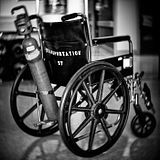Sunday, October 30, 2011
Another Day in Paradise
The day begins. My alarm clock goes off, and as consciousness slowly seeps in I find that I have been sleeping on my stomach, as is my habit. Flipping over is no easy affair, as my useless right arm and leg are dead weight, and, as an added bonus, the spasticity that attacks them makes them extremely stiff as well. I know from experience that simply trying to roll over like any normal person just won't work. I must will my right leg to bend at the knee, creating the momentum needed to set my body in motion. After a considerable amount of effort, my right leg bends in a sudden spasm, and as it does so I use the force generated to get myself situated first on my side, and then, finally, on to my back. The first success of the day.
That success does not come without a price, though. The maneuver results in searing pain that radiates excruciatingly from my hips. I suffer from Avascular Necrosis (click here), a rare side effect of intravenous steroid use that results in the death of the bones in the major joints. I have the condition in both hips and both shoulders; these days I'm living with the literal equivalent of two broken hips, as both of my femoral heads have collapsed. At their worst, my hips feel like they're made out of a sadistic mix of broken glass and blazing razor blades, producing a level of pain I formerly had no idea even existed. Some knowledge is best left unlearned.
The pain is bracing, and serves to knock some of the drowsiness out of my head. Not all of it, mind you, because the fragility of my joints dictates that I sleep in spurts, as every time I unconsciously adjust my body position during the night I am awakened with a generous jolt of ouch. Finally on my back, I clumsily reach for the alarm. As I do so, my left shoulder makes sure to remind me that it, too, is afflicted.
Next up is wrestling my rebellious body into a sitting position on the side of the bed. Aside from some pain, my left leg doesn't present much of a problem and makes the trip to the edge of the mattress under its own power. My right leg requires a little help from my left arm and hand, which I then use to hoist myself into a sitting position with the help of the handy dandy little railing that is attached to my bedside. I reach for the nightstand to grab the glass of pills that had been placed there the night before, a pharmaceutical cocktail designed to combat pain, spasticity, inflammation, bladder issues, and thyroid deficiency (and enrich the companies that make the meds).
After downing the pills with a slurp of water, I sit for several moments summoning the will to slowly and painfully uncurl my body into a standing position, after which, cane in hand, I'll take the two or three awkward steps to my wheelchair for the 10 foot trip to the bathroom. The anticipation of the effort required to complete these actions makes the notion of simply staying in bed quite appealing. But no, while I'm still able, I'll not consign myself to a bedridden day. There may be plenty of those forced upon me at some later date, the thought of which I try my best to put from my mind. Instead, still sitting on the side of the bed, I say to myself, out loud, "Another day in paradise…"
Of course, that phrase is uttered with a tremendous dose of sarcasm, but the words also serve to remind me of a simple truth. Today is the only today I'm ever going to have, regardless of the challenges it holds. Once it's gone, it's not coming back. It's nonrefundable, nontransferable, and has no shelf life whatsoever. Despite the value we place on so many shiny objects, the most precious commodity of all is time, as our personal allotment of it becomes scarcer with each passing second.
With luck, work, and savvy you can amass reserves of cash, or gold, or precious jewels, but time defies hoarding, instead forever slipping through our grasp despite whatever strategies we may employ to hold back its relentless flow. We've developed multibillion-dollar industries devoted to denying the passage of time, or at least the toll it takes on the physical body, but no amount of Botox or plastic surgery can delay the inevitable. On the contrary, the older we get it seems that our experience of time speeds up. That gloriously long two months of summer vacation we experienced as 10-year-olds now flashes by in what feels like a matter of moments. We are like rocks tumbling down a mountain, picking up speed as we go, racing ever faster towards a common end. One hundred years from now the world will be filled with all new people, the luckiest among its current occupants remembered by a precious few. We are but tiny specks in the vastness of an unknowable universe, each individual existence as inconsequential in a cosmic sense as a lit match viewed from a distance of a thousand miles.
Given that reality, each new dawn is indeed another day in paradise, aching hips and petrified limbs be damned. Those of us unfortunate to be burdened with disease should be all the more aware of the dearness of the moment at hand. When healthy, it's easy to take the tremendous good fortune of simply being well completely for granted, concentrating instead on all of the perceived impediments to our so-called God-given right to happiness. In fact, the right to happiness is a gift we give ourselves, by the choices we make and the actions we take. Yes, shit happens, but the way we choose to perceive that shit is what defines it as good or bad, happy or sad. No circumstance is inherently a disaster, or for that matter, a triumph, it is only our perceptions that make them so.
When I was healthy I used to not only sweat the small stuff, but agonize over it. Each setback was a calamity, each broken relationship or career impediment the vehicle for a descent into a pit of anxiety and depression. Looking back now, from within a deteriorating body, I can clearly see that all of those perceived misfortunes often led me to completely unexpected and usually improved circumstances, and that the only real obstacle to my finding contentment was in fact me and my insistence on clinging to the negative. While I was burning a torch for some lost love, I foolishly disregarded chances to find new and possibly truer affections. While stressing over a career that didn't always go as planned, I was blind to opportunities that in retrospect seem crystal clear. By concentrating on loss, I denied myself gain, time and time again.
Now, the inferno of illness has thrown light on to the folly of such behavior. Faced with physical limitations that are completely beyond my control, I am determined to make the most over that which I can still influence, my attitude and my actions. I'll never claim that my getting sick is some sort of blessing, as such inanities makes me ferociously nauseous. Getting sick sucks. Dealing with constant pain sucks. Experiencing creeping paralysis as a disease insidiously whittles away at my body sucks, sucks, sucks. I can think of no action so disgusting that I wouldn't undertake it if it held even the slightest chance of beating back this monster. If crawling up the rectum of an incontinent hippopotamus might somehow make me better, then coat me in Vaseline and get me to the nearest zoo.
Despite all of the opportunities for misery that chronic illness presents, or, maybe because of them, I am determined to squeeze the most out of however much precious time is left while I am still able, hopefully years rather than months. This is not to say that I am some sort of saint, sitting in an state of ethereal bliss in the face of what very well could be a dire future. Rest assured, I do my share of griping, moaning, and complaining. I am also not one of those patients inclined to attempt to scale Mount Everest or to be the first person to cross the Atlantic in a floating electric wheelchair. There are many days that the best I can muster is watching Godzilla movies in my underpants. But I am resolute that on such days, I will at least try to derive as much contentment as is humanly possible while watching Godzilla movies in my underpants. And, believe me, if you fully occupy the moment, and let neither thoughts of the past nor the future pollute the present, watching Godzilla movies in your underpants can be a very good thing indeed, especially if you have a box of chocolate covered pretzels to munch on while watching.
Yes, it's another day in paradise. I've come to realize that paradise is not a destination, but rather an environment that is created from within. Sitting on the side of my bed at the beginning of each new day, waiting for the pills to kick in, I try to remind myself of that fact, and some days it's much easier than others. But even on my worst days, when the walls and buttresses within reveal the chicken wire and chewing gum that they're made from, I understand that there's really not much choice. Time is fleeting, and we don't get bonus days for time spent miserable, however justified that misery may be. The path to paradise or perdition is one and the same; it’s how you choose to perceive the view along the way that makes all the difference.
Sunday, October 23, 2011
Bits and Pieces: I'm Grumpy Edition

Sorry about the long gap between these scribblings and my last post, but I've been dealing with computer issues for the better part of this week. When I say computer issues, I'm talking specifically about some kind of malevolent computer virus that is causing all kinds of wicked little jerks and twitches to afflict my electronic ball and chain.
Despite a robust antivirus program, and overly intrusive firewall, and numerous anti-malware scans of varying intensities (the very fact that the word malware exists proves that Machiavelli was right, and evil does indeed lurk in the hearts of man), my computer has nevertheless contracted some kind of illness, the intensity of which lies somewhere between a sniffle and the flu. Trying to rid the device of this bug has in turn infected me with an obsessive compulsion to weed it out and smash it to bits.
I'm maddeningly frustrated to report that so far all of my many hours of efforts have been in vain, and, in order to avoid a violent cerebral hemorrhage, I may have to call in someone who actually knows what they're doing. Since I like to live under the delusion that I know what I'm doing no matter what it is I happen to be doing, this last step will be taken only as a last resort, and with bitter resignation, like General Lee surrendering at Appotomax Courthouse. Such a rancorous humiliation…
Despite my current state of semi-sane, glassy eyed distraction, I offer up to you the following selection of noteworthy items, most of which have something to do with MS or disability. After which I will once again descend into the writhing bowels of war…
§ I came across a new (at least, new to me) MS blog called "My New Normals" (click here), which I find to be well-written, insightful, and very well designed. Written by an MS patient named Nicole, the blog features succinct accounts of Nicole's experiences living with MS, told in an accessible and direct manner that contains many truths and more than a little bit of wisdom. I appreciate her ability to sum things up quite succinctly, quite unlike my predilection for writing long-winded novellas. Kudos to Nicole, and welcome to the blogosphere (horrible word, sounds like something that might be embarrassingly launched from a nostril after a particularly energetic sneeze).
§ This past week, the ECTRIMS/ACTRIMS (European and American Committees for Treatment and Research into Multiple Sclerosis) meetings were held in Amsterdam. This is the biggest annual medical conference devoted solely to MS, and was attended by researchers and clinicians from all over the world. In addition to the usual avalanche of MS drug trial data released, topics at this year's conference ranged from the role of parasites in the treatment of MS, to CCSVI, to stem cell therapies, to genetics. There's an awful lot of info to digest, and what with my "war of the viruses" going on, I haven't been able to devote the proper time and attention needed to process all of this new information, so I'm afraid I'll have to weigh-in at some later time. Luckily, though, the MS society sent Julie Stachowiak (who writes the excellent MS column at About.com) and video producer Kate Milligan to Amsterdam to produce a blog about all of the research developments discussed at the conference (click here). They did a terrific job giving a day by day and blow-by-blow account of this massive conference, breaking down the info into understandable written posts and video pieces. Highly recommended reading/viewing.
§ Speaking of Julie Stachowiak, at her regular About.com gig, she's blogged about her recent experiences trying LDN as a treatment for her MS (click here). LDN stands for low dose naltrexone, a popular "alternative" treatment for MS. Naltrexone is a drug that is typically used to treat various addictions (inhibits the workings of the brain's opioid receptors), but in very low doses has been purported to have beneficial effects in treating MS and other chronic illnesses. Despite a tremendous amount of anecdotal testimony from MS patients who swear by the drug, there's been very little hard research done on LDN, primarily because the drug is old and off patent, meaning that there aren't billions of dollars to be made marketing it to patients. Therefore, there is no financial incentive for pharmaceutical companies to sponsor trials testing the efficacy of LDN, and since these days Big Pharma funds the vast majority of medical research done in the US, if they're not interested, treatments like LDN simply languish in a sort of medical twilight zone, tantalizing patients with promise but with no way to prove their worth. Truly a pathetic state of affairs, and one which only seems to be getting worse. In any event, Julie's relating of her experiences taking LDN makes for interesting and informative reading.
§ I'll be one of the hosts at a CCSVI MStery fundraising party being put on here in New York City on November 4, at the Hudson Eatery, located on 57th St. between 11th and 12th Avenues. Held on behalf of the Buffalo Neuroimaging Analysis Center (BNAC), which is doing extensive groundbreaking research on many aspects of CCSVI, attending the party and donating to the cause is a fun way to help further the CCSVI movement. The party will feature a silent auction which will include four of my photos (really nice 16 x 20 matted prints), the first time any of my photographs have ever been up for sale (yikes!). Dr. Robert Zivadinov, the head honcho and lead researcher at BNAC will be in attendance, and will discuss much of the CCSVI research he presented at ECTRIMS. If you're in the New York City area and want to have a great night out on the town while at the same time doing your bit for CCSVI research, you can register for the party by (clicking here). If you don't live in the area, or otherwise can't attend, but would still like to make a donation to BNAC, please do so through my "party host page" (click here), so that BNAC knows that the support has come from a Wheelchair Kamikaze reader. If you are be unable to attend the event but would like to bid on any of the auction items, you can do so via the magic of the Internet (click here). I look forward to meeting everybody who attends the party, and extend my thanks to all those who can't attend but still do their part to help further BNAC's research.
§ One other New York City-centric item: The Multiple Sclerosis Research Center of New York (headed up by my personal neuro, Dr. Saud Sadiq) will be holding its 14th annual free patient symposium on October 30, at the New York City Hilton Hotel on Sixth Avenue and 52nd St (click here). This year, the theme of the symposium is "Healing MS", which is, after all, the point of the entirety of MS research (at least I hope it is-there's always the "vast sums of money to be made off of desperate people" angle, which I can assure you plays no role in the very benevolent heart of Dr. Sadiq). These symposiums are always packed with valuable information, and offer glimpses into some of the cutting-edge research being done by the facility, in addition to reviews of the latest trends in treating multiple sclerosis. Topics scheduled to be discussed include preserving cognition, optimizing medical treatment, a question-and-answer on controversies (gee, wonder what those might be?), and, of course, healing MS. If you're in the area, this is an excellent opportunity for self education (and a free brunch).
§ I leave you with the following group of intrepid daredevils, The Red Wheelies, a British mobility scooter formation display team, who hold the current Guinness world record for "the greatest distance covered in 24 hours by a motorized scooter or wheelchair" (click here). While that achievement is indeed impressive, I'm more taken with their thrilling precision maneuvers, kind of like an air show but, um, on the ground and much slower…
With that, I take my leave, off to continue my conflict with my damned computer, which froze up while I was writing this last night, causing me to lose several hours work and delaying this post by a day. As far as my struggle with the computer virus goes, as Winston Churchill said, "This is not the end, this is not even the beginning of the end, but it is the end of the beginning…" Or, as my grandmother said, quite often, “Oy vey"…
Wednesday, October 12, 2011
Progressive MS: A Deep Mystery Beginning To Reveal Its Secrets?
The words "progressive multiple sclerosis" carry with them a sense of dread and panic for most MS patients. When I was newly diagnosed, I of course immediately hit the Internet, and discovered that there were four primary types of multiple sclerosis: Relapsing Remitting MS (RRMS), Secondary Progressive MS (SPMS), Primary Progressive MS (PPMS), and Progressive Relapsing MS (PRMS). It only took an hour or so of reading for me to realize that the progressive forms of the disease (SPMS, PPMS, and PRMS) were very scary indeed. Not that RRMS is any picnic, but patients with progressive MS have few if any treatment options, and generally suffer much more aggressive disease and a quicker rate of disability. My mind immediately rejected the notion that I might have one of these forms of MS, but as time played out and the course of my disease became clear, I was given the diagnosis I had come to suspect but refused to accept: PPMS. Now, after eight years, that diagnosis itself has come into question (click here), but still, the clinical course my disease most resembles is PPMS.
A spin around the Internet MS forums quickly reveals that there is much confusion about progressive MS among much of the MS population, especially the newly diagnosed. It's extremely important for patients to understand the differences between the MS subtypes, as treatment and symptom management options vary widely, and informed decisions can only be made if a patient has a good grasp on just what they're dealing with. There are several good sites that explain the differences between the MS subtypes (click here for one), so I won't go into an in-depth discussion of their differences here. In a nutshell, RRMS (which represents about 85% of the MS population) is marked by the disease course that features distinct relapses and remissions. During a relapse, an RRMS patient experiences an acute worsening of symptoms, often to a very debilitating degree. This is followed by a period of remission, when the patient reverts more or less back to normal, sometimes suffering from residual effects that remain from their previous relapses. After a period of years, a majority of RRMS patients transition to SPMS (click here for more info), when they stop experiencing relapses and remissions and instead start suffering from a steady increase in disability, with none of the distinct "ups and downs" of RRMS. In addition to a lack of relapses and remissions, SPMS patients also experience a severe reduction in the amount of inflammation seen in their central nervous systems, despite the ongoing nature of their disease.
PPMS patients (about 10% of the MS population) never experience periods of relapses and remissions, but instead suffer a steady decline in functionality from the onset of their disease. PPMS is distinct in many ways from the other forms of MS, so much so that some doctors and researchers think that it may in fact be a completely different disease. Unlike RRMS, PPMS attacks men and women in equal numbers. MRIs reveal that PPMS patients generally have less lesions than RRMS patients but usually exhibit more spinal lesions, and even though their lesion load is less, quite often their disease is much more aggressive and debilitating. Additionally, spinal fluid analysis is usually less definitive for PPMS patients, as they sometimes don't exhibit the telltale O-bands seen in about 95% of RRMS patients. Additionally, PPMS patients don't exhibit the widespread central nervous system inflammation that is one of the hallmarks of RRMS.
PRMS (about 5% of the MS population) is the rarest common form of MS, and patients afflicted with it experience a steady decline punctuated by acute exacerbations, which are not followed by remissions. This is generally the most aggressive form of the disease.
In my 8+ years of haunting various MS Internet forums, I've seen many patients confused about the differences between SPMS and PPMS, often wondering which variant of the disease they are suffering from. The difference is actually quite clear; if a patient has ever experienced a period of relapses and remissions, then they by definition cannot have PPMS. Anybody who has previously received a definite diagnosis of RRMS, and has experienced exacerbations followed by periods of relief, but now finds that they are now facing a decrease in relapses but a steady increase in symptoms, is likely transitioning to SPMS.
Almost all of the approved MS drug therapies are meant for RRMS patients and are effective to varying degrees in reducing the amount of relapses suffered by the patients taking them, benefits which are accomplished by modulating or suppressing the systemic immune system. At the present time, there is only one drug approved for SPMS patients, the chemotherapy agent Novantrone, and there are no proven effective treatments for PPMS. Often, MS Neuros will try some of the approved therapies on their progressive patients (usually their SPMS patients), in the hopes of positively impacting the disease, but these attempts generally prove to be unsuccessful.
Because of the aggressive nature of progressive multiple sclerosis, and the extreme difficulties in treating it, progressive MS remains a frightening proposition for patients and a confounding problem for the physicians trying to treat them. Often, treatment is limited to symptom management because none of the approved MS treatments, most of which work in one way or another to reduce inflammation in the central nervous system, have any positive effect on progressive MS patients who typically exhibit little or no CNS inflammation. One of the prevailing mysteries of MS is why, in the face of this lack of inflammation, the disease continues to progress without hesitation.
Research conducted over the past few years has started to shed light on some of the mechanisms at play in progressive MS. It appears that, at least in some of progressive MS patients (and especially in SPMS patients), a kind of rogue immune system develops within the patients’ central nervous system, which operates independently from the greater systemic immune system (click here, here, and here). This "immune system within an immune system" is comprised of lymphatic tissue (the kind that produces immune system cells) which develops within the CNS, safe behind the blood brain barrier. These lymphatic tissues produce immune cells (primarily B cells), which it is believed drive the continuing disease process seen in progressive MS. Because this process occurs behind the blood brain barrier, which functions to sequester the CNS from toxins and pathogens that might attack the rest of the body, it is protected from the drugs effective in treating RRMS, which work by down regulating the systemic immune system but have no effect within the central nervous system itself. This explains why drugs like Tysabri, which despite its known potential problems is very effective in treating RRMS (click here), have little or no efficacy in treating the progressive forms of the disease. The drugs simply have no access to the self-contained immune process that appears to be taking place within the central nervous system in some progressive MS patients.
The implications of these discoveries are tremendous. They suggest that therapies delivered directly into the central nervous system may be effective in treating progressive MS, and indeed, one study has demonstrated that intrathecal (spinal) injections of methotrexate do seem to be effective in treating progressive MS (click here [full disclosure, this study was conducted by my neuro, Dr. Saud Sadiq]). The NIH is currently conducting a study testing the effectiveness of intrathecal Rituxan in SPMS patients (click here). This also illustrates the importance of research done very recently that has demonstrated a possible method for temporarily opening up the blood brain barrier, allowing for delivery of drugs into the CNS (click here).
Furthermore, the development of immune cell producing tissues within the central nervous system means that addressing many of the suspected MS triggers (viruses, toxins, possibly CCSVI) would have little or no effect on the disease once this rogue immune system is in place. Indeed, we do have anecdotal reports that CCSVI treatment appears to be less effective in patients suffering from the progressive forms of multiple sclerosis, and none of the approved RRMS drug therapies has been shown to be of any benefit for progressive patients.
It took me quite some time to grasp the implications of this "rogue immune system" theory, but I've developed the following analogy that I think illustrates the problem fairly well. Imagine a lit match being held to a sheet of paper. The lit match represents whatever it is that triggers MS and the early RRMS stage of the disease, and the sheet of paper represents progressive MS. Once the match touches the paper and ignites it, extinguishing that match will have no effect whatsoever on the burning sheet of paper. Likewise, once a compartmentalized immune system develops within the CNS (the burning sheet of paper), extinguishing the conditions which allowed for it to develop (the lit match) will be ineffective in curtailing the disease. Indeed, this is exactly what we do see with current accepted MS treatment modalities, and, anecdotally at least, in the treatment of CCSVI.
Therefore, the possibility exists that there is a window of opportunity before these lymphatic tissues develop and the disease goes progressive during which the treatment of MS has its best chance of curtailing the advance of the disease.
Clearly, research priorities must be shifted to definitively identifying the underlying causes that initiate the aberrant immune response seen in MS, rather than simply finding new and more profitable ways of suppressing the immune system, many of which are of questionable effectiveness in stopping RRMS from transitioning to progressive disease (click here). Plainly, there are processes driving the disease even in its earliest stages that are not directly related to the systemic immune system. We must also learn if progressive disease is in fact driven in large part by a self perpetuating immune reaction developing within the CNS, and if so identify which progressive patients are suffering from this development, and of course also find safe and effective methods to fight it.
Science is finally beginning to tease apart the intricate puzzle of multiple sclerosis, but vigorous and innovative research is urgently required, as is a shift away from much of the current thinking about the disease, which has proven hugely profitable to Big Pharma, but of little value when it comes to eradicating MS. Real hope is on the horizon, but new maps must be drawn to finally deliver MS patients to the promised land.
A spin around the Internet MS forums quickly reveals that there is much confusion about progressive MS among much of the MS population, especially the newly diagnosed. It's extremely important for patients to understand the differences between the MS subtypes, as treatment and symptom management options vary widely, and informed decisions can only be made if a patient has a good grasp on just what they're dealing with. There are several good sites that explain the differences between the MS subtypes (click here for one), so I won't go into an in-depth discussion of their differences here. In a nutshell, RRMS (which represents about 85% of the MS population) is marked by the disease course that features distinct relapses and remissions. During a relapse, an RRMS patient experiences an acute worsening of symptoms, often to a very debilitating degree. This is followed by a period of remission, when the patient reverts more or less back to normal, sometimes suffering from residual effects that remain from their previous relapses. After a period of years, a majority of RRMS patients transition to SPMS (click here for more info), when they stop experiencing relapses and remissions and instead start suffering from a steady increase in disability, with none of the distinct "ups and downs" of RRMS. In addition to a lack of relapses and remissions, SPMS patients also experience a severe reduction in the amount of inflammation seen in their central nervous systems, despite the ongoing nature of their disease.
PPMS patients (about 10% of the MS population) never experience periods of relapses and remissions, but instead suffer a steady decline in functionality from the onset of their disease. PPMS is distinct in many ways from the other forms of MS, so much so that some doctors and researchers think that it may in fact be a completely different disease. Unlike RRMS, PPMS attacks men and women in equal numbers. MRIs reveal that PPMS patients generally have less lesions than RRMS patients but usually exhibit more spinal lesions, and even though their lesion load is less, quite often their disease is much more aggressive and debilitating. Additionally, spinal fluid analysis is usually less definitive for PPMS patients, as they sometimes don't exhibit the telltale O-bands seen in about 95% of RRMS patients. Additionally, PPMS patients don't exhibit the widespread central nervous system inflammation that is one of the hallmarks of RRMS.
PRMS (about 5% of the MS population) is the rarest common form of MS, and patients afflicted with it experience a steady decline punctuated by acute exacerbations, which are not followed by remissions. This is generally the most aggressive form of the disease.
In my 8+ years of haunting various MS Internet forums, I've seen many patients confused about the differences between SPMS and PPMS, often wondering which variant of the disease they are suffering from. The difference is actually quite clear; if a patient has ever experienced a period of relapses and remissions, then they by definition cannot have PPMS. Anybody who has previously received a definite diagnosis of RRMS, and has experienced exacerbations followed by periods of relief, but now finds that they are now facing a decrease in relapses but a steady increase in symptoms, is likely transitioning to SPMS.
Almost all of the approved MS drug therapies are meant for RRMS patients and are effective to varying degrees in reducing the amount of relapses suffered by the patients taking them, benefits which are accomplished by modulating or suppressing the systemic immune system. At the present time, there is only one drug approved for SPMS patients, the chemotherapy agent Novantrone, and there are no proven effective treatments for PPMS. Often, MS Neuros will try some of the approved therapies on their progressive patients (usually their SPMS patients), in the hopes of positively impacting the disease, but these attempts generally prove to be unsuccessful.
Because of the aggressive nature of progressive multiple sclerosis, and the extreme difficulties in treating it, progressive MS remains a frightening proposition for patients and a confounding problem for the physicians trying to treat them. Often, treatment is limited to symptom management because none of the approved MS treatments, most of which work in one way or another to reduce inflammation in the central nervous system, have any positive effect on progressive MS patients who typically exhibit little or no CNS inflammation. One of the prevailing mysteries of MS is why, in the face of this lack of inflammation, the disease continues to progress without hesitation.
Research conducted over the past few years has started to shed light on some of the mechanisms at play in progressive MS. It appears that, at least in some of progressive MS patients (and especially in SPMS patients), a kind of rogue immune system develops within the patients’ central nervous system, which operates independently from the greater systemic immune system (click here, here, and here). This "immune system within an immune system" is comprised of lymphatic tissue (the kind that produces immune system cells) which develops within the CNS, safe behind the blood brain barrier. These lymphatic tissues produce immune cells (primarily B cells), which it is believed drive the continuing disease process seen in progressive MS. Because this process occurs behind the blood brain barrier, which functions to sequester the CNS from toxins and pathogens that might attack the rest of the body, it is protected from the drugs effective in treating RRMS, which work by down regulating the systemic immune system but have no effect within the central nervous system itself. This explains why drugs like Tysabri, which despite its known potential problems is very effective in treating RRMS (click here), have little or no efficacy in treating the progressive forms of the disease. The drugs simply have no access to the self-contained immune process that appears to be taking place within the central nervous system in some progressive MS patients.
The implications of these discoveries are tremendous. They suggest that therapies delivered directly into the central nervous system may be effective in treating progressive MS, and indeed, one study has demonstrated that intrathecal (spinal) injections of methotrexate do seem to be effective in treating progressive MS (click here [full disclosure, this study was conducted by my neuro, Dr. Saud Sadiq]). The NIH is currently conducting a study testing the effectiveness of intrathecal Rituxan in SPMS patients (click here). This also illustrates the importance of research done very recently that has demonstrated a possible method for temporarily opening up the blood brain barrier, allowing for delivery of drugs into the CNS (click here).
Furthermore, the development of immune cell producing tissues within the central nervous system means that addressing many of the suspected MS triggers (viruses, toxins, possibly CCSVI) would have little or no effect on the disease once this rogue immune system is in place. Indeed, we do have anecdotal reports that CCSVI treatment appears to be less effective in patients suffering from the progressive forms of multiple sclerosis, and none of the approved RRMS drug therapies has been shown to be of any benefit for progressive patients.
It took me quite some time to grasp the implications of this "rogue immune system" theory, but I've developed the following analogy that I think illustrates the problem fairly well. Imagine a lit match being held to a sheet of paper. The lit match represents whatever it is that triggers MS and the early RRMS stage of the disease, and the sheet of paper represents progressive MS. Once the match touches the paper and ignites it, extinguishing that match will have no effect whatsoever on the burning sheet of paper. Likewise, once a compartmentalized immune system develops within the CNS (the burning sheet of paper), extinguishing the conditions which allowed for it to develop (the lit match) will be ineffective in curtailing the disease. Indeed, this is exactly what we do see with current accepted MS treatment modalities, and, anecdotally at least, in the treatment of CCSVI.
Therefore, the possibility exists that there is a window of opportunity before these lymphatic tissues develop and the disease goes progressive during which the treatment of MS has its best chance of curtailing the advance of the disease.
Clearly, research priorities must be shifted to definitively identifying the underlying causes that initiate the aberrant immune response seen in MS, rather than simply finding new and more profitable ways of suppressing the immune system, many of which are of questionable effectiveness in stopping RRMS from transitioning to progressive disease (click here). Plainly, there are processes driving the disease even in its earliest stages that are not directly related to the systemic immune system. We must also learn if progressive disease is in fact driven in large part by a self perpetuating immune reaction developing within the CNS, and if so identify which progressive patients are suffering from this development, and of course also find safe and effective methods to fight it.
Science is finally beginning to tease apart the intricate puzzle of multiple sclerosis, but vigorous and innovative research is urgently required, as is a shift away from much of the current thinking about the disease, which has proven hugely profitable to Big Pharma, but of little value when it comes to eradicating MS. Real hope is on the horizon, but new maps must be drawn to finally deliver MS patients to the promised land.
Saturday, October 1, 2011
Some New Photos, With a Twist
![026[1] 026[1]](https://blogger.googleusercontent.com/img/b/R29vZ2xl/AVvXsEie_iBXdz1tZF9ILdmzspY055C5B7EPZAqU8mrgdMbYY14mK5TgdXbUd67cRo62xKosYFEFyql3F134MivvXpfcr3k0Ffy6qtafuF-RLT0Epe4Ep1DWuIXGvyKbqqC6y55-6RMKyajhwyY/?imgmax=800) I've added some new photos to the Wheelchair Kamikaze photo gallery, but these are a little bit different than any of the other shots found there. Back before my neurologic difficulties robbed me of the ability to hold a camera to my eye (click here to see my wheelchair mounted camera set up), I loved taking photos with antique and toy cameras. Because of the decidedly low-tech quality of the optics used in many of these cameras, the images they produced had a surreal quality to them, almost like snapshots taken from a long-ago dream. I used to scour eBay listings, flea markets, and yard sales for cheap relics that were still in working order, knowing that each one would have its own unique but endearing quirks. Of course, none of these cameras were digital, and all used traditional film, which further makes them impossible for me to now use, as loading film with my one wonky but still working hand would be quite the achievement.
I've added some new photos to the Wheelchair Kamikaze photo gallery, but these are a little bit different than any of the other shots found there. Back before my neurologic difficulties robbed me of the ability to hold a camera to my eye (click here to see my wheelchair mounted camera set up), I loved taking photos with antique and toy cameras. Because of the decidedly low-tech quality of the optics used in many of these cameras, the images they produced had a surreal quality to them, almost like snapshots taken from a long-ago dream. I used to scour eBay listings, flea markets, and yard sales for cheap relics that were still in working order, knowing that each one would have its own unique but endearing quirks. Of course, none of these cameras were digital, and all used traditional film, which further makes them impossible for me to now use, as loading film with my one wonky but still working hand would be quite the achievement.Within two years of my diagnosis I was no longer able to hold a camera to my eye and had to sadly give up my yen for photography. I bitterly thought my photo days were over, until my disease progressed to the point where I needed a wheelchair. Once I got the electric beast, and embraced the freedom it allowed me, my wife insisted that I try to figure out a way to rig a camera to the chair, and pressed the point home by getting me a suitable camera and camera mounting equipment one Christmas. I was quite resistant to the idea at first, I think because I was afraid the results would not be up to snuff, and would only serve as evidence of just how much I'd lost to my illness. After a couple of goes at it, though, I found that the photos I took in my new, somewhat unwieldy manner actually weren't all that bad, and realized that once again I was back in business. Of course, the antique and toy camera fetish was out, as the only cameras suitable for my new set up were high-tech digital beasties, but, as they say, any port in a storm.
Lo and behold, a couple of months ago I discovered that there were some decidedly low-tech lenses available to be mounted on my high-tech digicam. I warily ordered one, called simply the "toy camera lens" (click here), from an outfit in Hong Kong, half expecting my money to disappear into the ether. Incredibly, three days later (!) a package arrived from Asia, containing my wonderfully cheapo new lens. It's a really strange creature, with an area of sharp focus in the center, surrounded by increasingly swirly and out of focus edges. It's kind of temperamental, and I'm still sussing out the best ways to utilize its eccentric charms. There's no autofocusing the thing, you actually have to focus it by hand, an old-school exercise that I somehow find very satisfying, even though it increases immensely the complexities of trying to take a photo with only one coopertive hand.
So, presented for your perusal are the following photos, all taken with my new toy camera lens. I'd really appreciate some feedback on these, as I'm pretty sure they won't appeal to everyone, but I think some will find their dreaminess appealing, and hopefully see something striking or compelling in them. If not, you have permission to tell me I'm nuts. Honestly, I'd love to hear all opinions, good or bad, so feel free to leave comments positive or negative, as all will be valued.
 |  |  |  |
 |  |  |  |
 |  |  |  |
 |  |  |  |
Subscribe to:
Comments (Atom)





